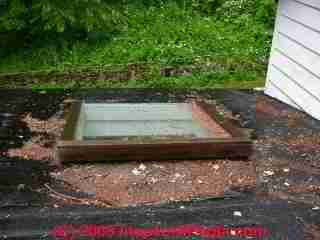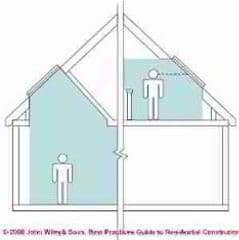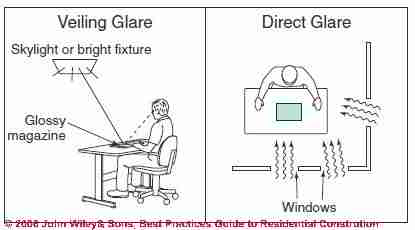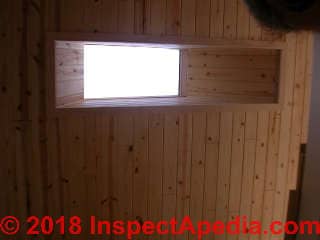 Design Issues for Skylights
Design Issues for Skylights
- POST a QUESTION or COMMENT about roof skylight design problems
Skylight design & installation problems that cause leaks or other failures:
This article discusses design issues for skylights such as choosing the proper skylight size, solving glare problems, handling splayed skylight openings, and skylight ventilation.
InspectAPedia tolerates no conflicts of interest. We have no relationship with advertisers, products, or services discussed at this website.
- Daniel Friedman, Publisher/Editor/Author - See WHO ARE WE?
Skylight Window Design Issues
 Article Contents
Article Contents
In this article series we discuss the selection and installation of windows and doors, following best construction and design practices for building lighting and ventilation, with attention to the impact on building heating and cooling costs, indoor air quality, and comfort of occupants.
We review the proper installation details for windows and doors, and we compare the durability of different window and door materials and types. This article includes excerpts or adaptations from Best Practices Guide to Residential Construction (Steve Bliss, J Wiley & Sons) , by Steven Bliss, courtesy of Wiley & Sons.
Our photo (page top) shows an older model skylight with factory-provided flashing and curbing. Despite lack of owner maintenance this unit is not leaking.
See WINDOWS & DOORS our home page for window and door information, and
also see WINDOW TYPES - PHOTO GUIDE for a photographic guide to window and door types and architectural styles.
Skylights can add a dramatic element to any room in addition to providing high levels of pleasing natural daylight. In the case of operable skylights, they can provide effective ventilation as well. On the other hand, too many skylights can produce uncomfortable glare and significant summertime overheating. A few simple guidelines can ensure a successful installation.
Sizing Advice for Skylights
A small skylight can go a long way toward brightening a space. However, too much direct sunlight can produce very uneven room lighting, excessive glare, and localized overheating.
A rule of thumb developed by the Florida Solar Energy Center recommends that a skylight should be 4 to 6% of the illuminated floor area.
This will provide a reasonable level of illumination (about 600 lux) during the morning and afternoon, and on days with overcast skies.
So, for example, 5 to 7 square feet of rooftop glazing (measured horizontally) will provide a reasonable level of illumination to a 10x12 kitchen. For skylights with frosted lenses or high up in cathedral ceilings, use a larger skylight; in regions with predominantly sunny skies, a smaller skylight should suffice.
Glare Problems at Skylights
Glare can be caused by a bright light source bouncing off a work surface into your eyes, or from a bright source directly striking your eyes from straight ahead or from an angle (Figure 3-19 below).

Figure 3-19
The best way to reduce glare from skylights is to provide diffused, even lighting over a larger area. This can be accomplished with frosted glazing or interior shades.
However, both of these block views of the sky, and interior shades require maintenance. Another approach is to use a light-colored skylight well to reflect and diffuse the light over a larger area.
Deep skylight wells can also reduce unwanted solar gains by as much as 25% by absorbing heat into the walls of the well area.
Splayed Skylight Openings
To maximize the daylighting potential of a skylight, it is best to paint the light well a light color and angle at least the top side of the well. Splaying the skylight well enlarges the opening at the bottom and brings the light deeper into the interior space, particularly in the winter when sun angles are lower.

Typically, the top side of the well runs at 90 degrees to the roof slope, and the bottom side, if splayed, is framed plumb (see Figure 3-20).
On very steep roofs where the top of the skylight is near eye level, a horizontal angle works well for the top side of the well.
The sides of the splayed skylight are usually left plumb to simplify the framing. Above: a splayed skylight in a northern Minnesota cabin. [DF]
See the separate "light well" at SKYLIGHT WINDOW WELL.
Also see SKYLIGHT LIGHT TUBES.
Ventilation Through Skylights
Ventilating through a skylight takes advantage of natural convection currents in a room that bring warm air toward the ceiling.
As the air is exhausted out the skylight, cooler air is drawn in through windows or other rooms. In rooms that generate a lot of moisture, such as kitchens and bathrooms, a venting skylight helps to control moisture levels as well.
Some skylights are equipped with flap-style vents that can remain open during rain without leaking.
Also see SKYLIGHT LEAK DIAGNOSIS & REPAIR
And see SKYLIGHT GLASS BREAKAGE
Skylight Manufacturers & Product Sources
Andersen Windows and Doors www.andersenwindows.com Skylights and roof windows with exterior sash clad with glass-fiber-reinforced material
Milgard Windows and Doors www.milgard.com Skylights with aluminum frames (thermal break optional) with vinyl subframes on operable models; optional motorized controls with rain sensor
Pella Windows and Doors www.pella.com Wood interior, aluminum exterior, optional motorized controls, and manual or motorized fabric-pleated shades
Roto Frank of America www.roofwindows.com Wood interior, aluminum exterior, optional motorized controls, and manual or motorized fabric-pleated shades; Sweet16 model fits 16 in. o.c. framing
Velux America Inc. www.velux.com Skylights and roof windows with wood interior and aluminum-clad exterior. Options include insect screens, blinds, motorized controls and shades with rain sensor, electrochromatic glass, and flashing kits for metal and tile roofs and mulled units
Skylight Light Tube Manufacturers & Sources
SolaTube www.solatube.com Light tubes from 10 to 21 in. in diameter; options include electrical lighting, daylight dimmer, and integral bath fan
Sun-Tek Skylights www.sun-tek.com Light tubes from 10 to 21 in. in diameter; options include electrical lighting and multitube Spyder skylight
Velux America Inc. www.velux.com Sun Tunnel light tubes from 14 to 22 in. in diameter with flexible or rigid tubes
Industry Associations for Windows & Doors
American Architectural Manufacturers Association (AAMA) www.aamanet.org
Efficient Windows Collaborative www.efficientwindows.org
National Fenestration Rating Council (NFRC) www.nfrc.org Sustainable by Design www.susdesign.com
Shareware calculators for sun angles, solar heat gain, and shading
Window and Door Manufacturers Association (WDMA) www.wdma.com
-- Adapted and paraphrased, edited, and supplemented, with permission from Best Practices Guide to Residential Construction (Steve Bliss, J Wiley & Sons) .
...
Continue reading at SKYLIGHT ENERGY EFFICIENCY or select a topic from the closely-related articles below, or see the complete ARTICLE INDEX.
Or see these
Recommended Articles
Suggested citation for this web page
SKYLIGHT DESIGN ISSUES at InspectApedia.com - online encyclopedia of building & environmental inspection, testing, diagnosis, repair, & problem prevention advice.
Or see this
INDEX to RELATED ARTICLES: ARTICLE INDEX to DOORS & WINDOWS
Or use the SEARCH BOX found below to Ask a Question or Search InspectApedia
Ask a Question or Search InspectApedia
Try the search box just below, or if you prefer, post a question or comment in the Comments box below and we will respond promptly.
Search the InspectApedia website
Note: appearance of your Comment below may be delayed: if your comment contains an image, photograph, web link, or text that looks to the software as if it might be a web link, your posting will appear after it has been approved by a moderator. Apologies for the delay.
Only one image can be added per comment but you can post as many comments, and therefore images, as you like.
You will not receive a notification when a response to your question has been posted.
Please bookmark this page to make it easy for you to check back for our response.
IF above you see "Comment Form is loading comments..." then COMMENT BOX - countable.ca / bawkbox.com IS NOT WORKING.
In any case you are welcome to send an email directly to us at InspectApedia.com at editor@inspectApedia.com
We'll reply to you directly. Please help us help you by noting, in your email, the URL of the InspectApedia page where you wanted to comment.
Citations & References
In addition to any citations in the article above, a full list is available on request.
- Basic Housing Inspection, US DHEW, S 352.75 U48, p.144, out of print, but is available in most state libraries; New York State version, ca 1955, source of our window parts and window repair sketches.
- Best Practices Guide to Residential Construction, by Steven Bliss. John Wiley & Sons, 2006. ISBN-10: 0471648361, ISBN-13: 978-0471648369, Hardcover: 320 pages, available from Amazon.com and also Wiley.com. See our book review of this publication.
- Our recommended books about building & mechanical systems design, inspection, problem diagnosis, and repair, and about indoor environment and IAQ testing, diagnosis, and cleanup are at the InspectAPedia Bookstore. Also see our Book Reviews - InspectAPedia.
- Decks and Porches, the JLC Guide to, Best Practices for Outdoor Spaces, Steve Bliss (Editor), The Journal of Light Construction, Williston VT, 2010 ISBN 10: 1-928580-42-4, ISBN 13: 978-1-928580-42-3, available from Amazon.com
- The Journal of Light Construction has generously given reprint permission to InspectAPedia.com for adaptations, quotations, or reproductions used at this website. All rights and contents of the JLC material are ©Journal of Light Construction and may not be reproduced in any form.
- In addition to citations & references found in this article, see the research citations given at the end of the related articles found at our suggested
CONTINUE READING or RECOMMENDED ARTICLES.
- Carson, Dunlop & Associates Ltd., 120 Carlton Street Suite 407, Toronto ON M5A 4K2. Tel: (416) 964-9415 1-800-268-7070 Email: info@carsondunlop.com. Alan Carson is a past president of ASHI, the American Society of Home Inspectors.
Thanks to Alan Carson and Bob Dunlop, for permission for InspectAPedia to use text excerpts from The HOME REFERENCE BOOK - the Encyclopedia of Homes and to use illustrations from The ILLUSTRATED HOME .
Carson Dunlop Associates provides extensive home inspection education and report writing material. In gratitude we provide links to tsome Carson Dunlop Associates products and services.


